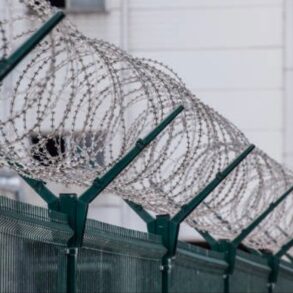By Alex Brizee
The Idaho Statesman
BOISE, Idaho — Quickly after an ambush last year at a Boise hospital injured three correctional officers when a prison transport turned dangerous, the director of the state’s prison system said he made immediate changes and would continue to review department policies.
Now, Idaho Department of Correction Director Josh Tewalt has requested millions of additional dollars this legislative session to address concerns that were uncovered after the planned attack at Saint Alphonsus Regional Medical Center.
Last March, Nicholas Umphenour shot and injured two correctional officers at the Boise Bench hospital while they were preparing to transport Skylar Meade, who was serving a minimum 10-year prison sentence, back to the state’s maximum security prison. Boise police accidentally shot and injured a third correctional officer when they responded to the scene.
Meade and Umphenour, who knew each other from prison, then led law enforcement on a 36-hour-long manhunt before they were apprehended in Twin Falls. They are linked to two North Idaho homicides — one in Nez Perce County and another in Clearwater County — that took place in that window, according to Idaho State Police.
Each suspect awaits trial on first-degree murder charges related to the case in Nez Perce County. If convicted they could face the death penalty. State police are still investigating the homicide in Clearwater County.
After the attack, the state’s prison system is asking for a nearly $2 million one-time expense to add new technology, equipment and staff “to address vulnerabilities,” Noah Peterson, a budget policy analyst for the state’s Legislative Services Office, told the Joint Finance-Appropriations Committee during a presentation last week. Gov. Brad Little outlined the budget request last month in his annual State of the State address, and supports it, Peterson told the legislative committee.
The supplemental requests will go toward making sure an attack like the one at Saint Al’s doesn’t happen again, he added. The department also is requesting a $4.5 million annual increase for ongoing costs related to the technology, salaries and other operating costs.
The largest one-time expense, more than $1 million, would fund a dozen new positions for the remainder of 2025 and equipment to expand the prison’s transportation bureau that moves people in prison between different facilities and handles intakes and releases. The new positions also would increase the agency’s annual budget by $965,500, Peterson said.
Those positions would allow the bureau to handle emergency transports — like Meade’s transfer — instead of typical correctional officers. Three officers were assigned to take Meade to Saint Al’s, though only one of them was armed.
“This was a planned event where they were able to manipulate our transport and get our staff in a really vulnerable position in ways that — candidly, as their director — I do not believe they were trained to respond to,” Tewalt told the committee. “So my response now, my responsibility as an agency is: I either give everybody at that facility that level of training or we bring in some specialized help to do these transports.”
While shift leaders look to assign officers who are qualified to use firearms and have some specialized training to handle high-risk transports, the transport bureau has training beyond that, Tewalt said. Those officers have specialized equipment, a higher level of firearm certifications including knowing how to shoot their weapons in low light and have additional medical and combat qualifications, he added.
IDOC wants to buy seven new vehicles, six of which would be SUVs, along with a wheelchair van that would all be equipped with window barriers, dividers, emergency lights and tinted windows.
“This is the most efficient manner we could come up with — to allow me to sleep at night, for starters — but also to make sure that we’re not over-resourcing, that we’re not committing resources that won’t be utilized,” Tewalt said.
IDOC wants to digitize prison mail, add anti-drone technology
A contraband cellphone was also partly to blame for assisting in Meade’s escape.
The 32-year-old communicated with Umphenour from his prison cell through a cellphone and they were able to detail their escape plans, discuss buying ammunition and share information about which guards would be carrying weapons, according to text messages presented in court.
Tewalt said that the “level of sophistication” being deployed to introduce prohibited items into correctional facilities across the U.S. is “unlike anything any of us in the field have ever seen.” To combat the innovative ways contraband is being brought into the prison system, IDOC also requested $795,000 to implement several new pieces of surveillance technology.
5 ways to improve drug and contraband interdiction in corrections mail
Specifically, the prison system is asked for funds to purchase software that would transcribe the millions of phone calls made by prisoners each year. They also want to add mail-scanning technology that would divert prisoners’ mail to an offsite location where it would be opened, scanned and sent to the residents digitally.
The Prison Policy Initiative, a Massachusetts -based nonprofit focused on criminal justice reform, has advocated against correctional systems implementing mail-scanning technologies. The organization argued that physical mail for people in prison holds sentimental value and that it could have a “chilling effect” on communication because people who don’t want their letters scanned or put into a searchable database.
Typically a “very small amount” of contraband comes through mail in correctional institutions, and, by eliminating physical mail, officials are in turn hurting people in prison, Wanda Bertram, a spokesperson for the initiative, previously said in an interview with the Idaho Statesman.
“You’re taking away someone’s access to a memento and a connection to the outside world — a reminder that your family is out there waiting for you,” Bertram said. “That’s important because that creates a less safe environment.”
But eliminating access to physical mail would remove the “most porous” point of entry for contraband and alleviate staff from screening “every piece of mail” that comes through the system, Tewalt told the committee.
“It doesn’t take the attempts to introduce contraband off the table, but it allows us to plug one hole and redeploy resources elsewhere,” he said.
One other technology request included a system that would detect when a drone enters the area near a prison facility, as prison officials warned in July that at least on one occasion a drone had been used in an attempt to introduce contraband into the state’s main prison complex south of Boise. During last week’s hearing, Tewalt said the prison has now seen two drone drops in just the past month.
“It’s not just a threat that we are trying to anticipate around the corner — it’s here,” he said.
—
©2025 The Idaho Statesman. Visit idahostatesman.com. Distributed by Tribune Content Agency, LLC.
This post was originally published on this site be sure to check out more of their content.








